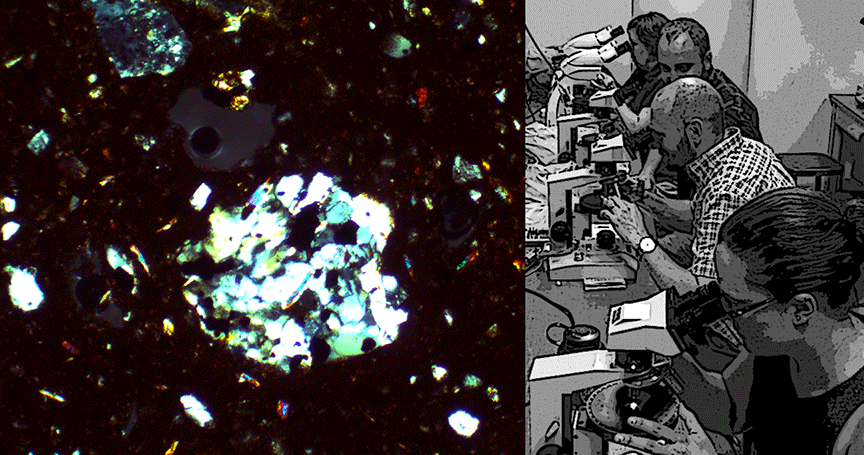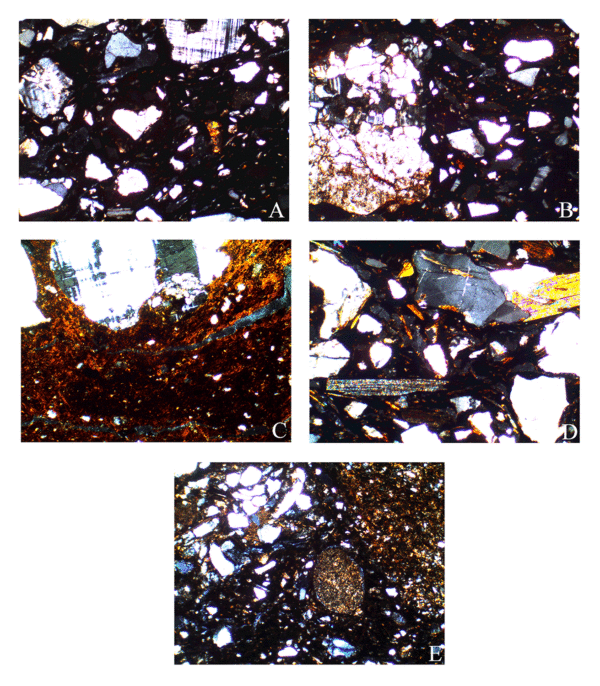
Mobility and Pottery Production
Dr. Mary Ownby, Desert’s resident ceramic petrographer, discusses her recent ceramic characterization study in northeastern Colorado, which was published this summer in the Plains Anthropologist journal.
When we think of ancient pottery making, we often picture a person sitting quietly, enjoying their craft near their house in a small village. Happily potting away (as we say!). While that is certainly the case for a lot of ceramic manufacture, especially in the Tucson and Phoenix areas with large perennial rivers, what about in other places? How can we understand making pots where people had a more semi-sedentary or seasonally mobile lifestyle?
Ceramic petrography uses a special geological microscope to identify the minerals and rocks fragments that were added as temper to clay used for making pots, to prevent shrinking and cracking.
Most potters tend to make pots near their raw materials. Thus, knowing the geological origin of components in the clay paste of the ceramic object can provide information on where it was made. You need good geological maps and hopefully some variability on the landscape, but typically a general idea of local (usually within 3 to 5 kms) or non-local can be achieved with this method. For the last 15 years I have examined many sherds this way for numerous projects in the southwest and beyond.
What I started to notice was that in some cases, pottery was not made near the villages, but closer to the base of mountains in areas where clay, sand, water, and wood (the latter particularly important for firing pots) were readily available. It appeared the groups were moving across the landscape seasonally and making vessels at particular times of the year in certain locations. I recently published an article in Plains Anthropologist with my colleagues Jason LaBelle and Halston Pelton describing just such a case.
We examined 40 brown ware sherds from 10 sites in the South Platte River Basin of northeastern Colorado. They range in date from the Early Ceramic (AD 150-1150), Middle Ceramic (AD 1150-1540), and Late Ceramic (AD 1540-1860) periods, with either cord-marked (mostly Early and Middle Ceramic), punctate, or plain surfaces (mostly Late Ceramic).

Map showing locations of sites examined in this study and previous petrographic studies. Map prepared by Kelton Meyer. See Ownby et al. 2021, Figure 1.
The mobility of these Late Prehistoric Era groups was well-known, particularly for the latter period, and such a lifestyle was highly probable for the earlier periods as well. The petrographic analysis of the pottery revealed that only one site, dated to the Middle Ceramic period, had pottery that was made in the basin area. The other sites contained granite inclusions suggestive of ceramic production in the Laramie Mountains to the west.

Map of site location, generalized geology, and temper source locations (prepared by H. Pelton). See Ownby et al. 2021, Figure 4.
Significantly, there was variation in the types of raw materials selected from alluvial clays, to redeposited secondary clays, to clay acquired very close to the parent rock (called residual clays). Petrographic examination of raw materials near the sites confirmed the pottery was mostly non-local, but also indicated suitable clays were available.

Photomicrographs (all cross-polarized light at 100x magnification), (A) Sample #13 (Kinney Spring) alluvial clay paste; (B) Sample #8 (Owl Canyon Rockshelter) alluvial clay paste with sand temper; (C) Sample #31 (Killdeer Canyon) shale-derived clay paste with sand temper; (D) Sample #3 (Roberts Buffalo Jump) residual clay paste; (E) Sample #26 (T-W Diamond) sedimentary secondary clay paste (prepared by M. Ownby). See Ownby et al. 2021, Figure 3.
The best explanation for this pattern is that seasonally mobile groups were making pottery in the mountains while exploiting plant and animal resources unique to that area. However, it has been commonly assumed mobile groups did not make pottery as it would easily break during regular movement from place to place. Recent research and ethnographic studies have begun to revise this picture, showing that Ute, Northern Paiute, and Blackfeet made pottery but for a specific purpose, cooking. Ceramic vessels are often the best containers for cooking, and the features of the vessels we analyzed (which contained large, angular temper fragments that allowed the pieces to withstand thermal shock) indicated they could have served this purpose very well. Most likely a small number of vessels would be made every year by a few individuals to meet the needs of the entire group. Not surprisingly, mobile rounds would not be based on when and where the lone potter wanted to work, as food and other resource acquisition was more important. Rather, pottery was made when it was most convenient, and that appears to have been when mountain resources were being exploited. Thus, we should envisage the potter sitting alone in the woods laboring at their craft while their families gathered plants and hunted animals nearby.
Resources
Mary F. Ownby (2017): Clay Choice: the Impacts of Ceramic Formation Methods and Cultural Behavior. In Innovative Approaches and Explorations in Ceramic Studies, edited by S.L. López Varela, 71-88. Oxford: Archaeopress.
Mary F. Ownby, Jason M. LaBelle & Halston Pelton (2021): Mobility and Ceramic Paste Choice: Petrographic Analysis of Prehistoric Pottery from Northeastern Colorado, Plains Anthropologist 66:1-36.


